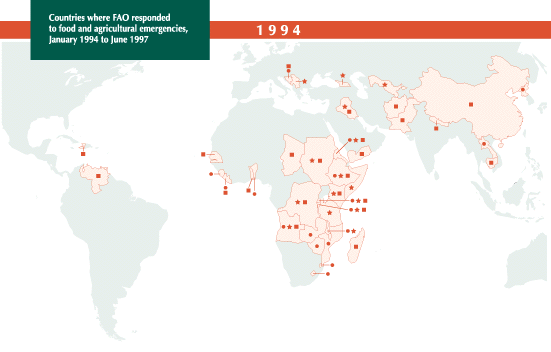

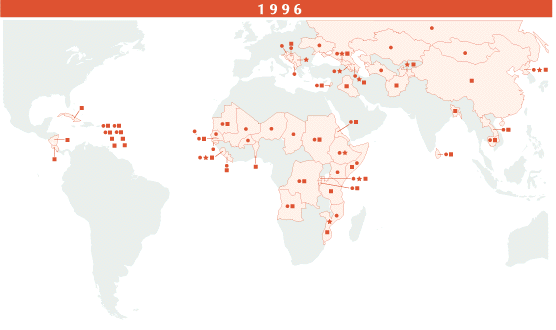
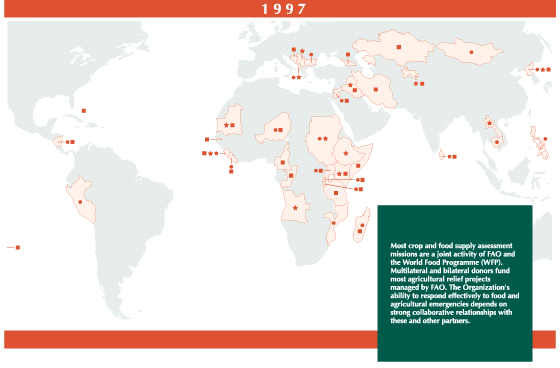
Drought, an insidious slow-moving disaster, destroys food crops, kills human beings and animals and has long-term effects on the environment. Drought affects population groups in different ways; understanding and monitoring these differences is important for preventing famine. Drought may, for example, result in unusual long-distance movement of herds in search of grazing and bring them into contact with new diseases. Irrigation systems may be affected, especially when the rains fail over successive years. Crop yields are reduced when irrigation water is lacking or becomes more saline. Shallow wells, water-holes and small reservoirs dry up or become contaminated, which affects human and animal health. The land loses the protection of vegetation and becomes vulnerable to erosion by wind and - when the rains finally return - to erosion by water. Erosion in turn results in loss of soil fertility, which reduces future crop yields. Increased runoff from eroded soil can bring flooding, silting up of dams and irrigation works and further erosion.
Pests and diseases can spread rapidly, heedless of national boundaries, with periodic outbreaks that can have disastrous consequences for crops, forests and livestock. The most dangerous plant pests are locusts and other types of grasshopper, armyworm and birds. The desert locust poses a recurrent threat to agriculture throughout Africa north of the equator, the Near East and Southwest Asia. Epidemics of contagious livestock diseases such as rinderpest and foot-and-mouth disease bring sickness and death to animals and disrupt trade between countries.
Floods are common occurrences in many countries. In some cases they are beneficial to agriculture, but unexpected floods resulting from abnormally heavy rainfall, sometimes hundreds of kilometres away, can be devastating: human lives, dwellings, livestock, infrastructure and communications can be swept away in a matter of hours.
Hurricanes, tornadoes, tropical storms and cyclones destroy standing crops, kill or injure livestock and damage homes, crops and food stores. High waves devastate low-lying coastal areas. Fishing communities suffer from storms through loss of life at sea, wrecked boats and damage to landing sites and equipment. Islands are particularly vulnerable: a single storm may be sufficient to destroy an island's infrastructure and cripple its economy.
Earthquakes destroy buildings and infrastructure and often cause heavy loss of life. Agriculture may be affected through burst dams, tidal waves or damage to standing crops or irrigation systems.
Volcanic eruptions result in deposits of ash and mud flows which can affect agriculture over a wide area, destroying crops and grazing land and clogging irrigation channels. They may force people to evacuate the immediate vicinity of a volcano, leaving standing crops and sometimes livestock behind.
Fires can destroy large expanses of forest in a few days, inflicting damage that can take years to restore. They can cause loss of human life, livestock, wildlife and crops as well as serious damage to property, livelihoods and the natural environment.
Man-made disasters cost the most in terms of human suffering, loss of life and long-term damage to a country's economy and productive capacity. The last decade has seen a marked increase in what are known as "complex emergencies" - complex because war and internal conflict lead to the breakdown and collapse of social, political and economic structures. Sometimes these emergencies are accompanied by natural disasters, which compound their complexity. Inevitably agriculture and food production are major casualties.
Droughts and floods, earthquakes and hurricanes, locust swarms and livestock plagues, war and civil strife - natural and man-made disasters take a heavy toll, whether measured in human fatalities and suffering or in economic losses.
The devastating drought that afflicted Ethiopia and several
other African countries in 1984/85 triggered a famine estimated to have killed more than 1
million people. A single cyclone that struck Bangladesh in May 1991 with wind speeds of up
to 270 km per hour left the lives of an estimated 140 000 people in ruins. Some
800 000 people were killed during the civil strife that ravaged Rwanda in 1994; more
than 2 million fled into neighbouring countries, and another 380 000 sought refuge in
camps within Rwanda.
Natural disasters do not discriminate. They strike rich and poor countries alike. But it
is the rural poor in the developing world who suffer most, those who are least able to
protect themselves, those who have no cushion of savings and no alternative means of
making a living. It is the poor, too, who have least choice about where they live, even
when they know that their home or livelihood may be endangered.
Poverty and vulnerability also increase in the face of man-made disasters that erupt as
civil wars rage and governments collapse. Essential services, including law and order,
break down. Infrastructure is destroyed and people flee the land, taking with them what
few possessions they can carry. Food production is no longer possible. People face
immediate hunger, and mass starvation threatens. Relief agencies rush to help, but unless
action is taken quickly to create the conditions in which people can return to their homes
and farming can start again, large numbers risk becoming dependent on relief in the long
term.
WITHOUT EARLY RECOVERY ASSISTANCE WITH EARLY RECOVERY ASSISTANCE
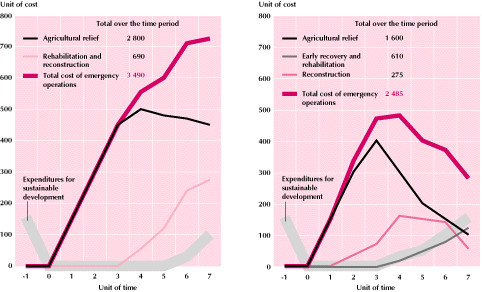
Cost-effectiveness of early action: costs of emergency
operations and speed of return
to sustainable development, without and with early recovery assistance
Region |
1994 |
1995 |
1996 |
1997 |
Africa |
507.58 |
408.65 |
211.37 |
106.89 |
Asia and the Pacific |
- |
13.45 |
25.91 |
110.38 |
Eastern Europe and Commonwealth of Independent States |
186.70 |
125.20 |
199.49 |
117.48 |
Near East |
33.55 |
86.21 |
- |
87.13 |
Total |
727.83 |
633.51 |
436.77 |
421.87 |
Region |
1994 |
1995 |
1996 |
1997 |
Africa |
21 539 912 |
5 226 278 |
5 887 066 |
5 885 656 |
Asia and the Pacific |
1 273 487 |
379 000 |
3 200 224 |
3 642 110 |
Eastern Europe and Commonwealth of Independent States |
859 084 |
8 470 079 |
10 540 335 |
701 488 |
Latin America and the Caribbean |
3 382 250 |
578 400 |
907 000 |
190 000 |
Near East |
10 824 332 |
6 136 826 |
6 659 675 |
23 737 766 |
Total |
37 879 065 |
20 790 503 |
27 194 300 |
34 157 020 |
The cost of disasters in human terms is intolerably high. In 1996 some 50
million people were displaced within their own countries or scattered abroad as refugees -
a dispersed nation of the dispossessed with a population equivalent to that of Spain and
Portugal combined. In that year, as a result of complex emergencies, around 40 million
people were depending on international assistance for protection or survival. The economic
cost is high, too. During the 1960s worldwide losses from both man-made and natural
disasters were estimated at US$1 000 million a year. Annual losses jumped to
US$3 000 million in the 1970s and to US$9 000 million in the 1980s, and they are
likely to rise even higher as the century draws to a close.
The flow of aid has reflected this increasing need. Funding for humanitarian assistance
has doubled since 1990, in a period when the overall volume of development aid has been
falling. In 1994 US$6 000 million were devoted to humanitarian assistance,
representing 10 percent of all the money spent on development aid around the world. The
United Nations now spends more than 50 percent of its budget on emergency relief, compared
with 25 percent in 1989. The bill for emergency operations managed by FAO has climbed from
$150 million for the entire decade of the 1980s to $170 million for just six years since
1991.
When disaster strikes, the media descend and fill the world's television screens with images of destruction and suffering. These images, beamed around the globe in seconds, make a vital contribution to the general understanding of the problems confronting the people affected by the disaster. They stimulate the worldwide mobilization of resources to help victims. But once the immediate crisis is over, the media move on. As a result the focus is on immediate relief efforts, and the public does not receive a complete picture of the wide range of humanitarian assistance that is provided to tackle emergencies.
In fact, some eight distinct phases can be distinguished in what has been called the disaster cycle or emergency sequence:
Recognition of the increasing cost and complexity of emergency operations has focused attention on taking preventive action and planning for disasters before they happen. In addition, when emergencies do occur, the emphasis is on moving as quickly as possible from relief to rehabilitation, reconstruction and sustainable recovery, so that affected households can free themselves from dependence on food relief, displaced populations can return to their own areas and refugee camps can be dismantled before they become permanent settlements. There is also now a greater understanding of the need for close cooperation and partnership among all the various agencies involved to achieve a new, more integrated approach to humanitarian assistance.
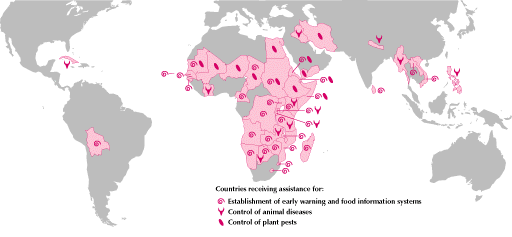
FAO assistance to help countries prepare for and prevent
emergencies caused by drought,
market disruption, and pests and diseases, January 1994 to June 1997
FAO is primarily a development agency, and its emergency activities reflect this focus. The Organization helps countries prevent and prepare for food and agricultural emergencies; provides early warning of their approach; assesses the impact of natural and man-made disasters on agricultural production and local food supplies; evaluates needs for immediate relief and longer-term recovery; delivers agricultural inputs and services to farmers in affected areas; helps countries plan and carry out agricultural rehabilitation and reconstruction work; and helps countries design programmes and projects that will lead to sustainable recovery and prevent vulnerability to future disasters.
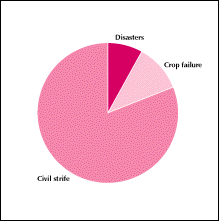
Value of jointly approved WFP emergency food operations,
January 1994 to June 1997, by type of disaster
Many of FAO's Field Programme activities contribute to reducing the vulnerability of agricultural communities to disaster. For example, the Organization provides support for better water control; higher-yielding crop production technologies; crop and livestock diversification; greater use of drought-resistant crop varieties; improved control of pests and diseases affecting crops and livestock; improved management of soils, rangelands and forested areas, including watersheds; better coastal fishing practices; home gardens and nutrition education; and improved on-farm storage, cereal banks and food security reserves.
FAO helps governments and regional organizations plan for disasters, including measures to mitigate their effects and to mobilize rapid relief and rehabilitation assistance, should this prove necessary. As a follow-up to the World Food Summit, FAO is helping member countries develop national food insecurity and vulnerability information and mapping systems. These will build on existing national food security information systems, many of which have been established with FAO assistance.
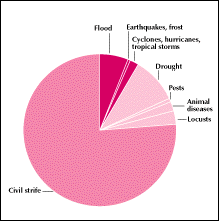
Value of FAO-managed agricultural relief projects,
January 1994 to June 1997, by type of disaster
FAO's Global Information and Early Warning System for Food and Agriculture (GIEWS) monitors food supply and demand around the world. It provides policy-makers and analysts with up-to-date information on crop prospects and gives early warning on imminent food crises. Also important in this regard is the Emergency Prevention System for Transboundary Animal and Plant Pests and Diseases (EMPRES), which keeps a global watch for signs of emerging threats from pests and epidemics. The information collected by these systems enables governments and international bodies to take action early in order to prevent emergencies from developing.
Drought. FAO can help agricultural communities prevent the worst effects of drought by improving land and water management practices, introducing drought-tolerant varieties and promoting diversification of crops and farming systems that provide alternative sources of food and income. Early warning at both the national and global levels is especially effective in the case of slowly emerging disasters such as drought; such warnings can often mean the difference between life and death for affected populations.
Plant and animal pests and diseases. FAO's EMPRES helps give early warning of impending pest and disease problems so that timely preventive action can be taken. EMPRES is initially concentrating on promoting effective containment and control of the most serious plant pests and animal diseases through early warning, rapid reaction, research and coordination. The Emergency Centre for Locust Operations (ECLO) specifically monitors the locust threat and the possibility of destruction by large flocks of birds. When infestations do occur, FAO experts can mount eradication and treatment programmes.
Floods. Forest and watershed management and the construction of flood control dykes help minimize the impact of flooding. When a food emergency develops, FAO helps organize relief.
Earthquakes and volcanic eruptions. Damage to standing crops, farm structures and livestock requires agricultural rehabilitation services which FAO is often best placed to provide.
Hurricanes, tornadoes, tropical storms and cyclones. FAO helps countries set up warning and information systems and advises on the use of hurricane-resistant crops and forestry methods, as well as helping agricultural systems and coastal fisheries get started again in the wake of the storm.
Fires. FAO advises on strategies for preventing fires and controlling them when they do occur. Relief and rehabilitation aid may include equipment and technical assistance with clearing and replanting.
Man-made disasters. FAO's early warning systems keep a close watch on the food and crop supply situation when it is threatened by political developments. When a complex emergency occurs, FAO focuses on trying to get farmers back to their fields so that disaster victims depend on relief aid for as short a time as possible.
To provide the right kind of help in an emergency it is essential to know the nature and extent of the disaster, how many people are affected and what help is needed. In the immediate aftermath of an emergency involving food and agriculture, FAO works together with the World Food Programme (WFP) to assess the situation and outlook for crops, food supplies and agricultural inputs and to estimate immediate needs for food and agricultural relief. As necessary, FAO mounts agricultural relief and rehabilitation missions to determine inputs and measures needed for the restoration of productive activity as soon as possible. Rapidly produced reports provide donor countries with crucial information to help them respond swiftly and effectively. Where relevant, this information is disseminated through consolidated inter-agency humanitarian appeals.
Relief efforts are aimed at saving lives in the immediate wake of a disaster. FAO's Director-General shares with the Executive Director of WFP responsibility for approving large WFP emergency food relief operations. FAO and WFP monitor pledges and deliveries of international food assistance and keep the international community informed of continuing needs. FAO, through its Special Relief Operations Service, arranges to buy and deliver agricultural essentials such as seeds, tools, fertilizers, fishing gear and livestock and veterinary supplies to permit immediate resumption of basic food production. The aim is to restore the assets and production levels of the affected communities as soon as possible.
Once emergency relief operations are under way, FAO, on request, helps governments and financing institutions prepare national rehabilitation and reconstruction plans aimed at restoring agricultural support services (extension, animal health, plant protection and input supplies) and rebuilding essential infrastructure.
During implementation of the plans, when the essential agricultural infrastructure is being rebuilt, FAO provides expertise in many areas, for example, rebuilding of fertilizer factories; repair of dams and irrigation systems; resumption of seed production; rebuilding of livestock herds; restoration of marketing infrastructure; repair of environmental damage, including damage to forests and soil quality; restoration of fishing industries; replanting of tree crops; and development of programmes for the resettlement and reintegration of refugees, the displaced and ex-combatants.
Once the situation has returned to normal, FAO helps governments formulate food and agricultural development strategies which include the framing of programmes and projects aimed at strengthening the resilience of rural communities against future disasters as part of the development process.
Because tackling disasters and resulting emergencies is such a complex task, many public and private bodies can contribute skills and experience. United Nations and government agencies as well as non-governmental organizations (NGOs) operating in the emergency area all have crucial roles in the process, and close cooperation is vital.
The United Nations Department of Humanitarian Affairs (DHA),
now being reorganized, was set up in 1992 with the prime task of coordinating the UN
response to complex emergencies and natural disasters. Its Inter-agency Standing Committee
brings together all the main UN bodies involved, including FAO, as well as the
International Organization for Migration (IOM), the International Committee of the Red
Cross (ICRC) and representatives of non-governmental interests.
FAO takes the primary responsibility within the UN system for preventive actions linked to
sustainable agricultural development, crop and food supply monitoring and needs
assessment, evaluation of agricultural relief requirements, and mobilization of the
assistance and resources needed to restore agricultural activity. However, FAO's wide
range of disciplines and skills, its long experience in the developing world and its
presence in the field allow the Organization to make a contribution in every phase of the
emergency sequence.
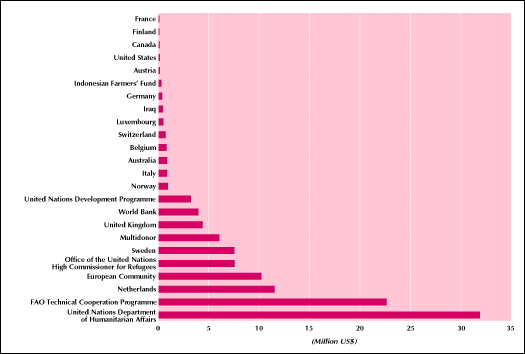
Value of FAO-managed agricultural relief projects, January 1994 to June 1997, by donor
WFP is one of FAO's most important partners. FAO's
Director-General and WFP's Executive Director have the joint authority to approve large
emergency food operations. The two organizations work closely in preparing early warning
reports and in assessing food relief needs and publicizing them among donors.
The Office of the United Nations High Commissioner for Refugees (UNHCR) focuses on the
needs of refugees and their resettlement and reintegration. Collaboration with FAO covers
such areas as assessing agricultural relief and rehabilitation needs, mobilizing funds,
providing emergency help to local food producers and supplying agricultural inputs to
refugees.
In most countries the Resident Representative of the United Nations Development Programme
(UNDP) acts as the humanitarian assistance coordinator, chairing a disaster management
team, which includes an FAO member. FAO's particular responsibility entails helping the
government coordinate its agricultural relief, rehabilitation, reconstruction and recovery
programmes, in which national and external partners often collaborate.
FAO has a long history of cooperating with the World Bank, the International Fund for
Agricultural Development (IFAD) and regional financing institutions on development
projects. Funds for agricultural inputs have been provided recently by IFAD and earlier by
the World Bank. These institutions also play an important role in funding investment
projects closely linked to rehabilitation, reconstruction and sustainable recovery
following complex emergencies.
FAO collaborates with ICRC and the national members of the International Federation of Red
Cross and Red Crescent Societies (IFRCRCS) in the early distribution of seeds and tools
following disasters. ICRC often intervenes directly in a conflict situation, and FAO
supports its activities by providing technical advice. ICRC has supported FAO by providing
logistic support for entering conflict areas.
FAO works closely at all stages of emergencies with international and private charities
dedicated to humanitarian assistance. NGOs are often FAO's main partners in complex
emergencies, contributing to monitoring and assessment of needs and to management of
relief operations. FAO, through procurement services and technical advice, helps NGOs
ensure that their operations in the areas of food and agriculture come up to accepted
technical standards.
Bilateral donors are, of course, essential partners, as it is their funds that finance
many of FAO's field activities at all phases of the emergency sequence. Except for small
amounts of seed money provided by FAO's Technical Cooperation Programme, the funding for
all FAO-assisted agricultural relief assessment missions and field operations and for many
emergency prevention and preparedness activities comes from extrabudgetary resources
provided by donors.
Within FAO the Emergency Coordination Group (ECG) ensures that the various units involved in emergency activities work efficiently together. ECG is chaired by the Director of the Office for Coordination of Normative, Operational and Decentralized Activities and has a secretariat provided by the office of the Special Advisers to the Director-General. Key units include:
Technical divisions provide technical support services,
contributing advice and assistance for the management of EMPRES, the identification of
vulnerable groups and their needs, the identification of inputs necessary to meet
emergency situations, and the design of relief and rehabilitation projects. Key units
include: the Agricultural Support Systems, Animal Production and Health, Land and Water
Development, and Plant Production and Protection Divisions; the Food Security and
Agricultural Projects Analysis Service; the Food and Nutrition Division; and the
Fisheries, Forestry and Sustainable Development Departments.
The Investment Centre Division prepares investment programmes and projects for funding by
major multilateral development banks during the rehabilitation and reconstruction and the
recovery phases.
FAO has field offices covering 110 developing countries, as well as regional and
subregional offices. UNDP provides representation services in other countries. At any time
FAO is involved in some 1 500 agricultural projects in the developing world; experts
working on these projects in affected countries are frequently called upon to help with
emergency needs assessments and field operations.
When disaster strikes, FAO's representatives in developing countries are quickly involved,
coordinating with the government and external partners, reporting directly to, and
supporting special missions from, headquarters. Often conditions are such that staff may
be in physical danger. FAO cooperates with the Office of the United Nations Security
Coordinator and operates a 24-hour hot line for field staff at risk.
In countries facing complex emergencies, FAO coordinates actions that address emergency agricultural needs and assists in the development and implementation of strategies for creating conditions conducive to recovery and sustained development. FAO's approach is to set up coordination units that:
- provide technical assistance to help nationals manage the existing
array of agricultural relief projects;
- monitor developments in the food situation;
- advise the numerous humanitarian organizations involved in the sector;
- help establish the country's capacity to move beyond the emergency to the recovery and
rehabilitation phase; establish information collection and database management systems.
These activities bring together all government institutions, donors and NGOs engaged in the sector.
Since 1994, FAO emergency coordination units have been set up in Bosnia, Tajikistan, Rwanda, Burundi, Liberia, Sierra Leone, Somalia, Iraq and Angola.